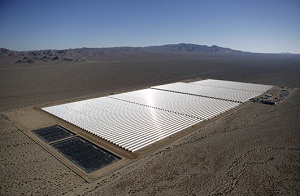Nevada to expand solar outside of mandated zones
 The United States Department of the Interior, Department of Energy and the Bureau of Land Management will begin hosting a series of public comment meeting on its proposed solar development plan in Nevada on Tuesday.
The United States Department of the Interior, Department of Energy and the Bureau of Land Management will begin hosting a series of public comment meeting on its proposed solar development plan in Nevada on Tuesday.
Charlotte Overby, acting executive director of the Nevada Wilderness Project, said her organization is thrilled to see proposed solar development zones in Nevada and will tell authorities that in public comment in Las Vegas this week.
“But we do plan to speak out in opposition of opening an additional 21 million acres to solar development,” she said.
The Solar Development Programmatic identifies seven distinct zones in Nevada that would be ideal for major solar installations. But the government proposes opening additional lands to solar development as well.
Overby said the Wilderness Project opposes that because it defeats the purpose of creating zones and managing solar development in an organized and logical fashion.
“What’s the point of establishing zones in the first place, if you’re just going to let development happen anywhere,” Overby said.
Within some of the unzoned area that could be developed for solar energy production is 1.1 million acres of identified Sage Grouse breeding grounds, Overby said. The Sage Grouse is a protected species in peril of making the endangered species list if it’s not defended from further losses.
Overby said that clean energy development will be key for Nevada and that the state welcomes the idea of building a new green economy. With more than 87 percent of the undeveloped land in the state belonging to the government, it’s the state with the most public lands in the country outside of Alaska and could stand to benefit tremendously from a federal decision to use desert lands to generate clean power, Overby said.
Most of that open space belongs to the BLM.
“We’re very excited and optimistic about the zone concept,” Overby said. “What we would like to see developed is a mechanism to establish new zones in Nevada.”
She said the zones create easier-to-manage regions that can be studied for environmental impacts before they are used for solar-energy development, Overby said.
She said the public comment meetings are good place to speak up and have your voice recognized.
Pictured: Nevada’s Solar One facility, courtesy of Cnet.



